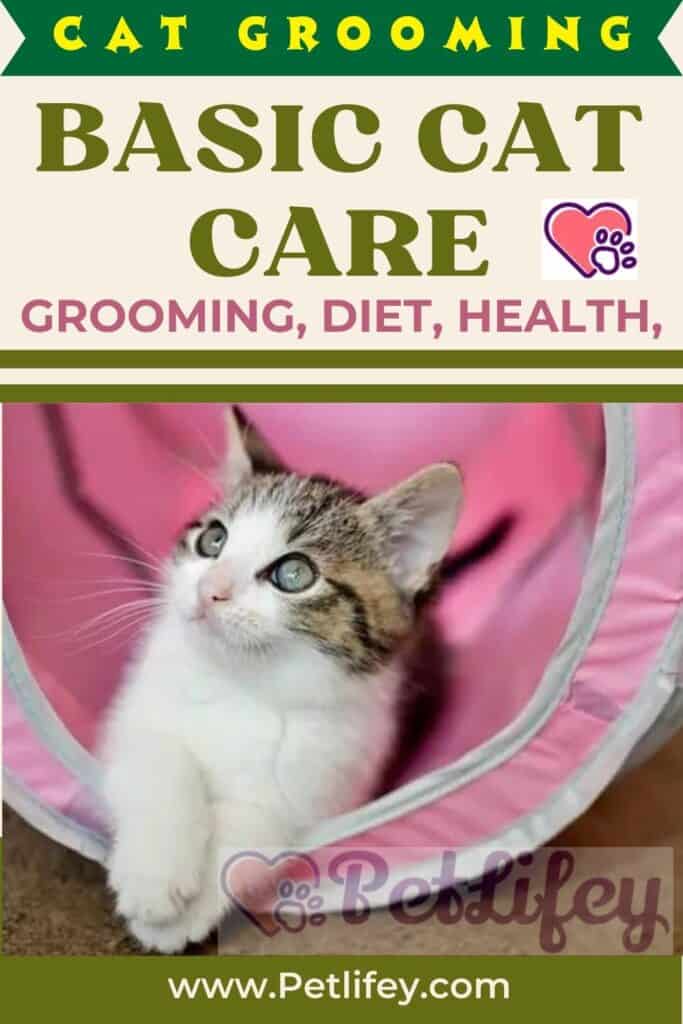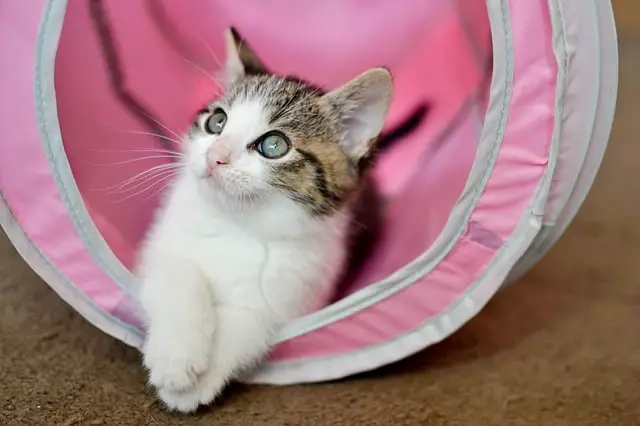
Having one or more feline pets is a pleasure, but it comes with responsibilities. The basic care that cats need are essential to guarantee a life full of health, happiness and well-being for your pet.
Choosing a vet for your cat
If you already own a cat or are thinking of owning one, you need a vet nearby. If you have a feline pet for the first time or have recently moved, the first thing you should do is contact a veterinarian or a veterinary clinic.
Sometimes your pet shelter, breeder, or vendor will be able to suggest a certain vet they already know.
You can also choose a vet who lives close to your home, or a friend or family member may recommend one. Whichever way you select it, you will have to do it as soon as possible.
If you feel satisfied with your regular vet, you should continue with them throughout your cat’s life, just as you would your family doctor.
This is convenient for you and your pet, because the veterinarian will get to know your cat’s personal medical history in depth and because you can trust them in everything related to the health of your companion animal.
Don’t try to play the role of your vet. Their general knowledge of symptoms can be of great help to your veterinarian when treating your cat and can be vital in an emergency situation, but it is not enough to allow you to replace the care of an experienced veterinarian.
You should know as much as possible about cat care, but make sure you learn from reliable and accurate sources. Incorrect treatment can, in many cases, be as harmful as the disorder it is trying to cure.
Knowing what to do in case of shock, poisoning, run over or something similar will allow you to provide your kitten with the necessary care while you go to the vet; In many cases, this knowledge can make the difference between your pet’s survival and death.
But, always remember that you are complementing and not replacing the veterinarian’s care. Learn everything you can about the daily care of your animal and what is necessary to keep it healthy. Should your cat become ill, your knowledge of the symptoms as they develop will be of great help to the vet when prescribing the appropriate treatment.
Documentation file – Your cat’s primer
Whatever the breed of cat you have or if it is mixed or Creole, you should keep a file of your cat, in which you will have the registration or registration documents, dates and results of vaccinations, treatments with dewormers and tests, dates of the booster injections and any other medical or breeding-related information.
This system will allow you to easily find any information when you need it and remember when to go to the vet for regular vaccinations and other regular treatments.
Although it is not a pleasant thought, if you die, the person or people who take care of your cats will know how to provide them with the appropriate care and treatment. In each cat’s file you can indicate their food preferences, allergies and other useful information that you would normally have in your memory.
For obvious reasons, it is recommended to always keep the vaccination record up to date. We all have many things to think about; it is less easy to forget or ignore something if we write it down.
Feeding a cat
Cats should be fed a well balanced diet rich in protein. Many of the commercially prepared cat foods are complete on their own. The base can be fish, game, beef or organ meats, and vitamins and mineral supplements are added.
However, not all canned or packaged cat foods are complete, and you will have to read the label to find out if they are or not.
Government regulations governing the pet food industry are strict, and only products that meet all of the cat’s nutritional needs can say so on the packaging.
You will see that your cat enjoys a varied diet. Ideally, you should give them dry feed or granules and canned food. Most canned foods are complete and must be fed to the animal once a day. Dry feed is often a favourite in the diet of felines and helps keep the cat’s teeth free of tartar.
Although not advisable, many owners also give their cat scraps of their food. If you can’t resist giving your pet some human food, be very careful not to give it chicken bones or fish bones, which splinter easily and can dig into the animal’s esophagus.
Some of the cats’ favorite human foods are egg yolk, egg salad, queso fresco, milk, cheese, liver, kidneys, chicken, ground beef, and raw and the cereal flakes (without sugar) very crunchy.
You may notice that your cat loves milk, but that it causes diarrhea. It is not advisable to give milk to cats, only milk for puppies that you can buy at your veterinarian, specialized centers or online.
Fresh food should not be allowed to sit at room temperature long enough for bacteria such as salmonella to grow in it. Never leave wet food for your cats when you go on a trip.
In that case, you should only give them dry feed. The flies could lay eggs in wet food and within a few days the eggs would hatch into larvae.
Occasionally, your cat will go through periods of loss of appetite. Generally, this is not a cause for concern and after a day or two the animal will return to normal feeding. It is possible that your cat has eaten a fly, a cockroach or something similar and has gotten sick from the insecticide that may have been on or in the bug.
Another possibility is that your pet has gotten tired of certain foods. Change your diet a little; try giving it other brands or varieties. Write down the things your cat likes and dislikes. Some cats eat dog food, but certain varieties may have chunks that are too large for most cats to eat.
If your cat likes dog food, give it to them every now and then as a treat. Remember that a cat’s dietary needs are different from a dog’s, and what is a complete dog food is not necessarily a complete food for a cat.
It is very common for cats to eat less than usual during hot summer days. This is completely normal feline behaviour, which is to be expected.
Food is to be given at regular intervals. If you feed your cat twice a day, it will be a good idea to give them its food in the morning and at night, to match your own meals. You can leave it dry as a treat. Water must always be available, and it must be changed frequently.
Some people provide their cats with a community feeder; others think that each animal should have its own feeder. Some cats gobble up their food quickly, others are finicky eaters, and still others eat slowly but surely. An individual feeder allows each cat to eat at their own pace, comfortably.
Cats eat their fill, even if this means leaving food in the feeder. New cat owners who previously owned dogs are often surprised by this behavior, because dogs eat until there is no food left in the feeder.
Although you may see cats swapping their feeders during a meal, they will each eat the appropriate amount if enough food has been provided. Opinions differ as to the amount of food that needs to be provided to a cat .
When your cat has reached adult size, give them enough food to maintain its weight, condition, and appetite. If your animal gains weight, reduce the amount of food.
Before your cat has reached adult size, allow them to eat as much as it wants so that its skeleton and muscles can develop properly. If your young cat is clearly eating much more than is normal for her size, she likely has intestinal parasites (roundworms) and a fecal sample will need to be taken to the vet for testing.
Some people salt their cats’ food during the summer to encourage them to drink more water. Cats drink when they are thirsty, and it is not unreasonable to assume that they drink more when they are hot. It seems superfluous to salt your food.
It is possible to provide additional liquid in the diet by giving them egg shakes, chicken broth or beef. Most cats like these foods and will gladly accept them if offered.
The most important thing to remember in relation to the cat’s diet is that it must consist of complete , balanced, and regularly provided foods. If your cat can’t digest something you have given them, it will probably vomit it up right away. This way you will realize the things that you should not give them.
Every cat is an individual, and while some foods like chicken, liver, and shrimp are liked by almost all cats, yours may reject some of them. Know what your cat likes and vary its diet with those foods; you will surely find them among the many complete and balanced varieties available on the market.
External care of a cat
Cats require certain care that can be called “maintenance”. In other words, they must be carried out periodically to guarantee the proper health of your feline pet. Let’s see the most important:
Cat brushing
You have to accustom the cat to the use of a brush or any utensil that you want to use to care for its coat while it is young. Kittens don’t need a lot of outside grooming, but if you get them used to this routine while they’re still young, they won’t resist when they’re older.
The brushing the fur of a cat must be done regularly and should be a pleasant experience for both the cat and for you. Regular coat care keeps the coat free from ticks and fleas, prevents the coat from tangling and caking, and helps remove dander that develops as the cat renews the skin under the coat.
Twice a year, when preparing for winter or summer, the cat will shed or thicken its coat. This is less noticeable in cats that live indoors than in those that live outdoors, but it does not stop occurring.
Brushing removes excess fur and in those times it should be done daily; This also prevents the formation of hairballs in the cat’s stomach, caused by ingestion of hair when the cat is grooming itself.
Trimming the cat’s nails
The front nails must be trimmed when necessary. There are several types of suitable nail clippers; Make sure you have one that is suitable for cats and not for dogs. The thin red line inside the nail (the “nerve”) marks the beginning of a blood vessel. Do not cut it, because it would be very painful for the cat.
If you do not know how to cut the cat’s nails, or if you fear hurting it, cut only the end of the nail, where it is sharpest. When you take the cat to the vet for the first injections or for a check-up, ask them to teach you how to trim its nails. It is seldom necessary to trim the nails on the hind legs, except before a show.
Cleaning the cat’s ears
Occasionally you have to clean the ears with cotton wool and mineral oil. The accumulation of brown matter in the ears indicates the presence of mites that have to be eliminated. Your veterinarian will do the first treatment and will teach him how to perform the subsequent preventive care.
Do not put medicine or objects into the ear canal. Cat ears are very sensitive, and you can cause permanent injury if you try to do something about it.
Cleaning the cat’s eyes
Cats’ eyes do not usually require special care, unless they are sick. The matter that appears daily in the corners is usually cleaned by the cat itself, when it has dried. If your cat is lazy to wash its eyes, you can clean them with a piece of toilet paper .
Bathing the cat
The best rule of thumb when it comes to bathing is this: if your cat needs a bath, bathe it.
But keep in mind that the shampoo for humans is too strong for cats (you must use one of the shampoos for cats).
Wash your cat with lukewarm water. Rinse very well to remove all the soap, thus preventing the skin from drying out due to the removal of natural oils, and then dry it well to avoid catching a cold.
How to Give Medication to a Cat
Cats do not usually drink or eat food to which some medication has been added, so it is necessary that you know how to give a pill, pill or a few drops to your cat .
The simplest way to give a liquid medicine is to use a plastic dropper (it is recommended not to use a glass dropper, which could break if the cat bit it).
Put the dropper at the corner of its mouth and squeeze the bulb gently so that the cat receives a small amount of medicine that it can swallow without choking.
Repeat the operation as many times as necessary until the animal has ingested the specified amount. You may be able to give the medicine with a teaspoon, but many cats will resist this.
There are several ways to give a cat pills; but the most effective is to hold the cat tightly against your body and grab its head from above. With four fingers on one side of its head and your thumb on the other side, open its muzzle and tilt its head back.
With your free hand, throw the pill into the muzzle, as far as possible. Close its mouth (this will force them to swallow). A few strokes, a few words of affection and a treat will help the cat regain its dignity.
You may find it easier to give them a pill coated in butter or fish oil or something similar; This is especially useful when a large capsule needs to be given to the cat. Remember that the gentler but more efficient you are, the more tolerable the situation will be for you and the cat.
How to take a cat’s temperature
To check a cat’s temperature or see if it has a fever, lubricate the end of a rectal thermometer with petroleum jelly. Grab the cat’s tail near the base and gently lift it to expose the anus.
With your free hand gently insert the thermometer, about 3 to 5 cm. Hold the cat and leave it with the thermometer on for about three minutes to get an accurate reading.
This may seem like the longest three minutes you’ve spent with your cat, especially if it’s your first time. Remain calm and comfort the cat at all times, because the animal does not enjoy this operation.
Be careful not to touch the end of the thermometer when removing it, as the reading could be altered.
The normal temperature for a cat is about 38.3 ° C; a different temperature indicates a disease. Similar to what you have to do when you give it a pill, help the cat regain its dignity when you are done.
How to care for an old cat
Cats age just like we do. They calm down, play less than when young, sleep longer, perhaps picky eaters, and occasionally have bladder “accidents”.
As with humans, the lifespan of felines is variable, and some cats age more quickly than others.
It is very difficult to establish precisely what is the normal duration of a cat’s life, but it can be said that it is eight to fifteen years.
The chances of a long life increase with proper care and nutrition, and it is not uncommon for some cats to live to be eighteen or twenty (especially if they have spent their lives indoors and have not been allowed to roam freely. ).
Successes in nutrition research and disease treatment have greatly helped increase the longevity of today’s cats. Negligence, serious illness, insufficient nutrition and poor housing are some of the factors that reduce the longevity of our cats.
There is no reason, with the exception of serious illness or accidents, why cats cannot live long and happy lives.
As our cats age may begin to have problems with rheumatism-Semitism, the arthritis, the heart disease, the prostatitis or kidney infections, but modern medicine has made it possible to reduce the debilitating effects of these diseases.
The cats deaf, blind or partially sighted may require care more spice-les they age, but proper care and affectionate consideration of the needs of any old cat (especially with regard to rest, reducing periods spent on gambling) should allow you to comfortably live your life with us.
Identification tattoo on cats

Tattooing cats in order to identify them is a relatively recent custom. Generally the tattoo is done (with needles and inks) on the inside of an ear or in the groin area .
Currently, no feline registry organization penalizes tattooed cats at exhibitions, although one of them, the CFA ( Cat Fanciers Association ), requires that the tattoo be no more than 7 digits long, not exceed 12.5 mm in height, and that it is located only inside the left flank.
Thus, only in CFA competitions and exhibitions are cats with ear tattoos disqualified. Naturally, if your cat is going to be a simple pet or a reproductive animal, the place where it has been tattooed does not matter.
Not all vets do tattoos, so you may need to do your research before you find one that does. It is advisable to tattoo the cat when it is still young.
You will probably have to take your kitten to the vet’s office early in the morning, and leave them there all day. The risk of infection from the tattoo is minimal if the cat is properly tattooed by an experienced veterinarian.
Tattoo identification is permanent, lasts for the life of your cat and allows you to positively identify your cat if it is lost or stolen.
In many cases, a breeder will sell a kitten with a clause in the sales contract that requires it to be neutered at a certain point. If the cat is tattooed, it is easy to check with the vet if the neutering was carried out on that particular animal. Breeders also use tattoos to identify members of different litters.
As cats become more popular and more expensive, the tattoo is likely to become more and more popular.






